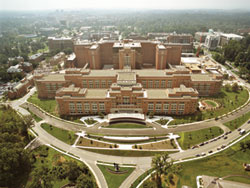


The Clinical Center at the National Institutes
of Health in Bethesda, Md., is the nation's
largest hospital devoted to clinical
research
NCI is leading an initiative to facilitate collaborations between intramural and extramural investigators by leveraging the NIH Clinical Center. At this national "clinical research laboratory" an important early-phase clinical trial for an aggressive form of a rare cancer, hereditary medullary thyroid carcinoma (MTC) was launched in July, 2007. The trial will determine whether the investigational agent vandetanib may be the first effective nonsurgical treatment in young patients with this cancer. But this trial is significant for another reason: It is the first being conducted at the NIH Clinical Center under the joint leadership of an NIH intramural clinical investigator and an extramural scientist. Dr. Frank Balis, from NCI's intramural research program, is the principal investigator (PI), while Dr. Samuel Wells, from Washington University in St. Louis and one of the world's foremost MTC experts, is the adjunct PI. Dr. Wells was involved in the discovery of a proto-oncogene, called RET, associated with the hereditary disorder multiple endocrine neoplasia (MEN). Patients with subtypes of MEN are at high risk of developing MTC and other endocrine tumors. Dr. Wells also helped to establish the efficacy of prophylactic thyroidectomy in children with RET mutations associated with these MEN subtypes.
After leading early-phase trials that demonstrated the activity of vandetanib in adults with MTC, Dr. Wells approached NCI about conducting a trial in children. It offered an ideal opportunity to pursue an intramural/extramural scientist-led trial. NCI worked with NIH leaders to make the arrangements allowing Dr. Wells to serve as a PI of a Clinical Center trial.

Patient rooms are in close proximity
to cutting-edge laboratories doing
related research
It is with rare cancers that the Clinical Center's value truly shines. Because NIH can recruit patients from around the country, trials performed at the Clinical Center are more likely to enroll enough patients with rare diseases to provide the statistical power needed to produce meaningful results and inform clinical care. Conducting the trial at the Clinical Center also allows investigators from other NIH institutes with expertise in endocrinopathies and MEN syndromes to participate. In addition to helping to write the trial protocol, these investigators provide clinical care to trial participants. And many patients in this trial—as well as members of their families, since this is a hereditary syndrome—will likely participate in additional studies, ensuring that the most scientific value from and clinical benefit for each patient during their treatment can be achieved.
The trial's Phase I/II design allows it to both determine the safest drug dose that can be given to pediatric patients and to evaluate its potential efficacy. The trial also involves biomarker and pharmacokinetic analyses, as well as analyses of tumor samples in the laboratory of NCI's Dr. Paul Meltzer to study whether there are genetic mutations associated with resistance to the agent.
This trial highlights a new vision of collaboration and partnership. It maximizes the potential of a single trial to provide as much data as possible so that the results can be quickly translated into patient benefit.